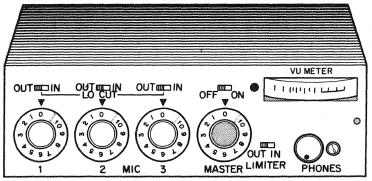Audio Control
It is possible to treat audio control as little more than a semi-automated routine. You just clip on a mike, and rely on automatic gain control circuits to adjust program sound. But when you want consistent high-grade sound, or are dealing with a production of any complexity, skilled audio control is essential.
The purpose of audio control
All the production’s audio sources are fed to an audio control console (board, desk, mixer panel). Here the sound from microphones, disk, audio and video tape, film etc. can be selected, controlled and blended. The audio output is continually assessed on high-quality monitor loudspeakers.
The audio qualitycan be modified by emphasizing or diminishing parts of the audio spectrum; using various kinds of filter systems such as graphic equalizers/audio batons. Reverberation can also be added where necessary, to enhance the‘ liveliness’ of any source.
Audio contral techniques
The audio control engineer/sound mixer’s attention is,divided between:
• Selecting each.source at the right moment, and fading/switching out other sound channels where necessary.
• Adjusting the outputs of various audio sources. Checking that no source exceeds the audio system’s upper limits and distorts; or becomes too quiet, and lost in the background.
• Blending the relative volumes of these selected sources, to create an appropriate sound balance.
• Keeping the overall strength of the final combined audio signal within the system’s limits — by continually adjusting a master fader, while watching a volume indicator (VU meter, PPM, visual display unit).
• Following the script, and the director’s intercom (talkback) information for upcoming changes, program continuity, etc.
• Checking the technical quality of the audio (e.g. for distortion, background noise, breaks, hum, clicks, etc.).
• Matching the artistic quality of the program sound with each shot, ensuring that it has appropriate scale (i.e. volume relative to the subject’s apparent distance), the acoustics are convincing, and the overall sound balance and audio quality fit the picture.
• Scrutinize picture monitors (showing preview and line/transmission shots), to warn the sound crew against microphones coming into shot, boom shadows, wrong sound perspective (mike too close or too distant for the shot).
• Guide and cue various members of the sound crew who are operating booms, positioning mikes, playing audio disk and tape inserts (for sound effects, music, recorded commentary, etc.).
• Liaison with other members of the production team (director, lighting, cameras).
• Perhaps operating disk or tape equipment.
Basic audio contral
Microphone (1) plugs into studio wall outlet(2) and the audio is amplified (3).(4) A side-chain audtion/pre-hear circuit provides, check-point before further processing. A preset attenuator/pad . (5) adjusts channel amplification (gain) and a channel fader (slide, quadrant or knob) (6) controls it overall.

Portable audio mixer
Used in the field to mix up to three mikes; the overall output is controlled by a master fader. A bass cut can be switched in to cut wind-rumble and improve intelligibility. A VU meter provides a volume indicator. This mixer includes a limiter, to prevent-audio overload. A phones check-jack monitors the audio.

